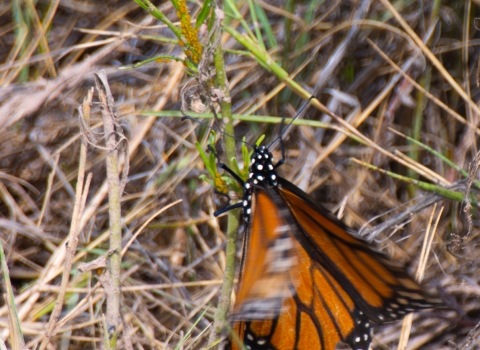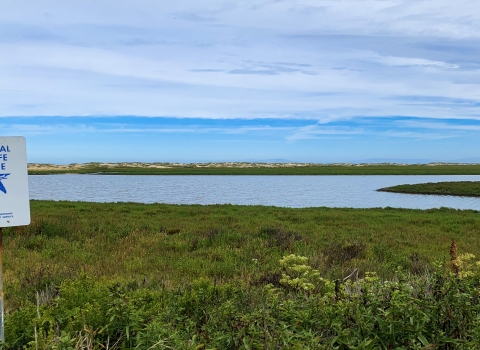Wildlife biologist Dirk Stevenson captures and researches the recently federally listed Suwannee alligator snapping turtle for the U.S. Fish and Wildlife Service. His work has furthered our understanding of its life history, distribution, and population dynamics.
Story by Dirk Stevenson
We wade rib deep to inspect our four-foot diameter hoopnet trap, set the night before in the quiet dark waters of a recently flooded Alapaha River swamp. This type of freshwater turtle trap is custom made, significantly larger than your conventional turtle trap, an XXL one might say. Our target, the Suwannee alligator snapping turtle (Macrochelys suwanniensis), also an XXL, is one of the largest freshwater turtles on the globe.
We are anticipatory, checking a turtle trap is always exciting. As we approach the trap twitches, just once, then goes quiet. It’s overcast, and you can’t see into the tannin-stained water. Cautiously, I dip my snake hook to gently lift the trap from the river, soon a long oval form takes shape. I make out rugged keels on its back, a blocky yellow head ending in a hooked beak. We have captured a 65 lb. male alligator snapper.
The snapper sits motionless on the riverbank, mouth ajar, awaiting processing (as part of a population monitoring study, all of our captures are measured, weighed, sexed and marked). We all stare at the turtle, it’s hard not to admire the animal. The huge head is as wide as it is long. Large oddly shaped scales atop the head fit together like puzzle pieces. The shell appears as if sculpted from stone; three formidable keels reinforce the top of this dense fortress.
We watch him. The turtle returns our gaze, his eyes slowly changing positions in their orbits. The eyes of alligator snapping turtles are unique. Golden irises broken by black spokes that radiate from the pupil. A ring of fleshy projections, arranged in a star, encircle the eye.
As you may know, alligator snappers are unique in possessing an oral predatory lure- the worm-like process attached to the floor of their mouths. Smaller turtles wriggle their wigglers to lure fish and other prey within biting range. Although they may lure on occasion, larger adults are opportunistic scavengers.
At low water, the Alapaha is stunningly gorgeous. Wine-colored water slips over terraces of white sand. You can wade across it. When the river’s up, it’s another story. Like after Hurricane Debby. Her downpours fed a dramatic rise in river levels, up to 14 feet. High water that hops the bank and floods cypress-tupelo sloughs and oxbows back of the river mainstem. The gator snappers like this.
Radio-transmitter studies of the species conducted by Florida turtle expert Travis Thomas and colleagues in the mainstem of the Suwannee River documented adult alligator snappers commonly moving into floodplain swamps, most likely to forage when they are inundated. Such conditions are intermittent, and as water levels drop the turtles are sometimes stranded in receding pools, forcing them to march overland to get back to the river.
A diet rich in fish, shellfish, fruit, and nuts sound like part of the regimen of a 2024 Paris Olympian. Interestingly, a similar meal plan is the norm for alligator snappers, which, despite their predatory characteristics including a bite force of 1,150 psi that makes us nervous, are omnivorous. In addition to a diet heavy in fish, snappers consume, where available, lots of freshwater mollusks, including the quarter-sized, non-native Asiatic clam (Corbicula fluminea). Very large snappers have been observed crawling along the river bottom pressing their sensitive snouts to the sand ꟷ in search of these locally abundant clams.
Based on records from Suwannee gator snapper feces, we know they use their jaws not only to pulverize catfish, gar, small turtles and snake prey, but also to grab and mush acorns, wild grapes, saw palmetto berries, water tupelo drupes, persimmons and paw-paws. The role of this leviathan as a seed disperser may be underappreciated - 35% of common persimmon seeds collected from a Suwannee alligator snapper fecal sample by researcher Jerry Johnston germinated. Nuts and fruits may be most accessible to snappers that sojourn into flooded swamp forests to forage during high-water events.
We continue to admire our 65 lb. male and ponder his story. Just what he has been doing in this swamp? Ripe acorns are dropping, and large persimmon trees grow upslope of the swamp edge. Gator snappers are strongly aquatic, causing us to wonder whether he has ever been on dry land since his hatching many decades ago. His large claws are surely reminiscent of those of a bear, as is his diet. We nominate a new local name for Macrochelys suwanniensis: “River-Bear.”
#







